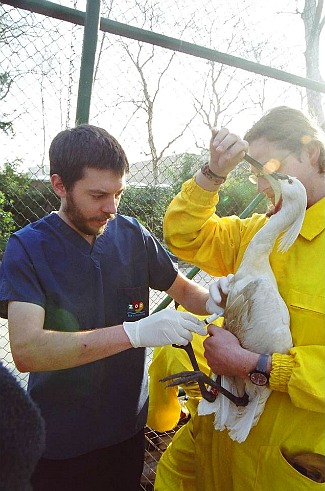Vaccination campaigns against avian influenza virus. Do they work?

Avian influenza (AI) virus has been considered a great threat during last years, especially after the outbreaks caused by H5N1 HPAI virus. Aquatic wild birds, including Anatidae (ducks, geese and swans) and Charadriidae (shorebirds), are widely considered to be the natural reservoir of AI virus. In 2002 an outbreak of H5N1 HPAI virus in Hong Kong caused mortality in a wide range of avian species, including migratory birds and resident waterfowls. In 2005, another outbreak of H5N1 HPAI virus killed over 6,000 water birds, in northwest China.
Due to unprecedented morbidity and mortality caused by H5N1 HPAI virus and given the value of birds kept in zoos, in 2005 the European Commission directive 2005/744/EC allowed vaccination against AI virus in such birds in zoos, under strict surveillance. In 2006, 15 Spanish zoos and wildlife centers underwent a vaccination program with a commercial inactivated H5N9 vaccine. Between November 2007 and May 2008, birds from 10 of these centers were vaccinated again with a commercial inactivated H5N3 vaccine, as decided by the Spanish government.
The current study was designed to assess the immunological response elicited after each vaccination individually; and also to observe and compare the effect of successive heterologous vaccines. To date, this is the most comprehensive study reported concerning number of animals and species.
To evaluate the humoral immune response induced after both vaccinations, specific antibody titers were determined by hemagglutination inhibition (HI) test. Higher HI titers indicate higher antibody response. Results obtained by HI demonstrate that both vaccines are efficient, eliciting high HI titers (>100). However, we observed heterogeneity in the antibody responsesin vaccinated birds, which varied greatly, not only between taxonomic orders but also between species of a single order and even within species. The most interesting finding is that, although some avian species (those belonging to Psittaciformesorder) did not show HI titers for any of the single vaccination; when priming with H5N9 and subsequently boosting with the H5N3 vaccine induced a significant antibody response (>32), albeit at lower titers than the others.To design future vaccination strategies in exotic wild birds, it is important to evaluate both, the response against the vaccine and the durability of HI antibodies. On average, the birds had titers less than 20, meaning that 1.5 years after vaccination, we cannot detect HI titers in serum samples.
An important alternative to increment the immune response and protect a wide number of wild birds against a possible infection with H5N1 HPAIV is a primer (H5N9)-boost (H5N3) vaccine strategy. The results obtained with the present study, together with the results from similar Studies carried out in other EU countries are an important tool to design future vaccination protocols.
Sampling.
This work was partially supported by the AGL2007-60434/GAN projectfunded by the Spanish Government and by the EUROFLU project(SP5B-CT-2007-044098) funded by the European Union.We are grateful to staff at participating zoos for their collaborationand kind help in data compilation, including Rocío CanalesMerino (Safari Park Vergel), Loles Carbonell (JardínZoológico de Valencia), Sergio Fernández Hernández(Selwo Marina and Selwo Aventura), Daniel García Párraga(L'Oceanogràfic), Candelaria González Villavicencio(Águilas Jungle Park), Ayose Melián Melián(Palmitos Park), Tania Monreal Pawlowsky (Marineland Mallorca),Miguel Angel Quevedo Muñoz (Zoo Botánico Jerez),José María Rodríguez Linde (Oasys Parquedel Desierto de Tabernas), and Fernanda Valdés García(Senda del Retiro), as well as staff at Faunia, Zoo Aquariumde Madrid, Zoo de Fuengirola, and Parc Zoològic de Barcelona.
References
"Comprehensive Serological Analysis of Two Successive Heterologous Vaccines against H5N1 Avian Influenza Virus in Exotic Birds in Zoos” by Júlia Vergara-Alert, Hugo Fernández-Bellon, Núria Busquets, Gabriel Alcántara, María Delclaux, Bienvenido Pizarro, Celia Sánchez, Azucena Sánchez, Natàlia Majó and Ayub Darji. Clinical and Vaccine Immunology, May 2011, p. 697-706, Vol. 18, No. 5 doi:10.1128/CVI.00013-1.


